
After our meeting at the factory we’re working with, the president of said factory treated us all to a feast at our restaurant. As Chinese tradition dictates, such feasts are accompanied with many, many toasts. The toast works this way: the person making the toast picks out a specific person to toast, walks over to that person, raises his/her glass and gives the toast. The translator translates. The person receiving the toast answers back. The translator translates back. Then both toaster and toastee down drinks in one swallow. After this, the glasses are immediately refilled by one of the servers.
In our case, the liquor used for toasting purposes was either red wine or bai jiu, a Chinese white wine that is actually more of a distilled liquor. The Chinese love bai jiu, which has a distinctive flavor. It’s about 50 percent alcohol and has a front end taste that is kind of like the essence of an infusion of dirty socks in some sort of floral alcohol and a back end like lighter fluid. It’s an acquired taste, and one that I had sort of acquired after a zillion toasts.
As the meal progressed, the toasting evolved into each toast requiring the downing of both a glass of red wine and a glass of bai jiu. Thank God we ran out of red wine and baiu jiu before I ran out of consciousness. The photo above shows me just before downing a glass of each after a toast from the head of operations at the factory.
The meal we had was spectacular. And pretty low-carb. I kept a photo log of it, which I will lay out below. (We had another good meal earlier in the day that MD posted about moments ago.)
We started with shark fin soup, which I didn’t take a picture of because…I don’t have a good reason. I just didn’t. I guess I didn’t think about taking photos until after the shark fin soup. From there we moved on to a giant prawn and an abalone. Both were delicious, especially the abalone. I don’t know what kind of sauce it was cooked in, but it was savory and out of this world.
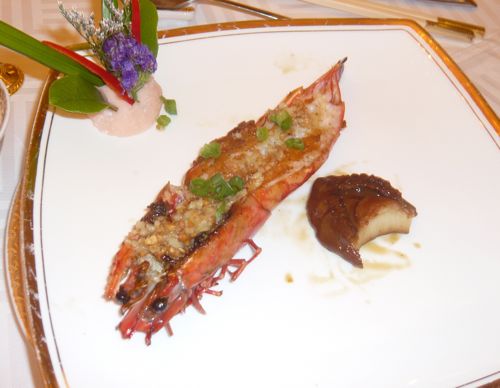
Then came a weird dish that was served with plastic gloves. It was a baby dove with head included. You put the gloves on and tore the little bird to pieces and gnawed the bones. And, yes, we ate the head. We didn’t just throw it back and chomp it; we nibbled off the small amount of meat on it . I watched the Chinese so I could follow suit, and that’s what they all did. After picking the bones clean, we all removed our gloves and awaited the next course.

What came then was some sort of seafood salad. And remember, all this food was interspersed by dozens of toasts.
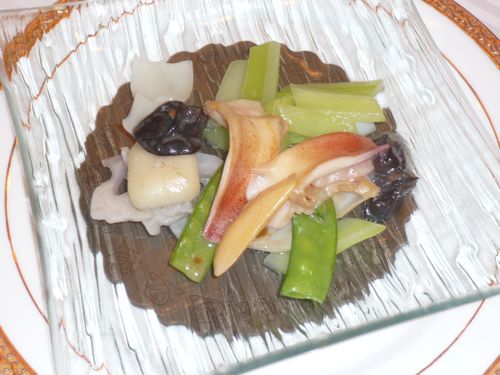
After the seafood salad came the main course, which was a piece of succulent steak that was extremely tender. It was served with a little pile of fried garlic chips and a stalk of broccoli.
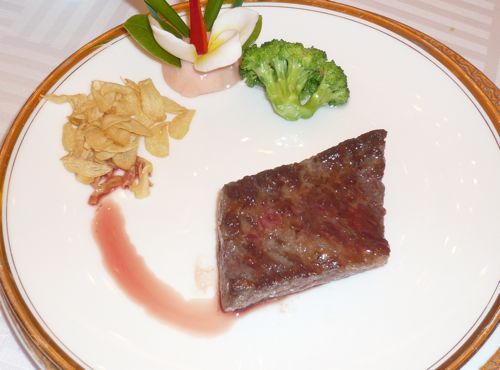
Following the steak, we had a dish of some kind of green vegetable. I never could figure out what exactly it was, but it was very tasty. I asked the woman sitting next to me what it was, but she didn’t know the English word for it. All she could tell me was that it was grown in the area where we were.
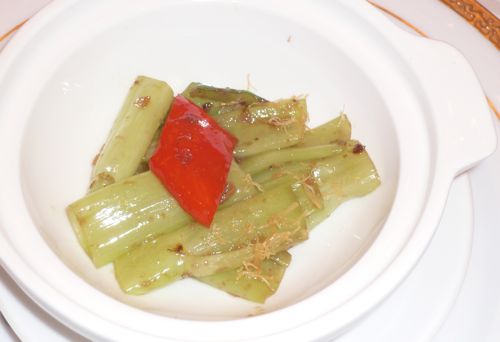
Then came a tiny bowl of fried rice. You can see the size of the bowl by comparing it to the spoon next to it and the little glass the bai jiu is served in.
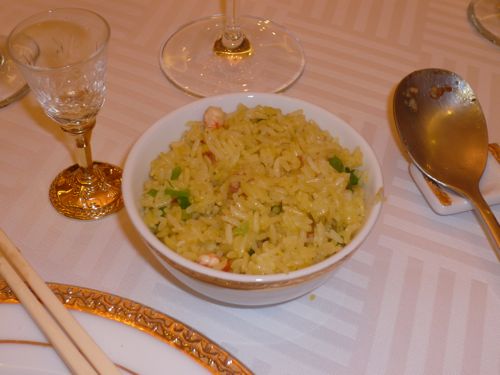
The we had some sweets, which I admit to eating. Everyone of them. By that time, after all the wine and bai jiu, I would have eaten anything.
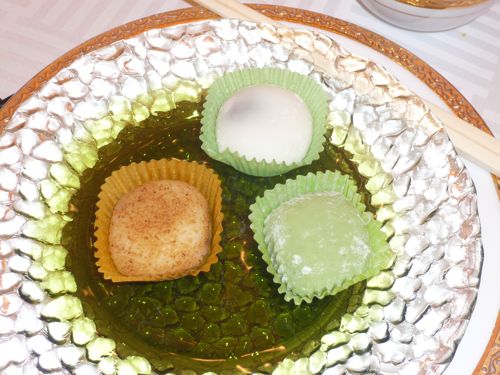
And finally we were served a small plate of fruit for the end of the meal.

By that time all the wine and bai jiu were gone, thank God. I thought we had made it through the worst of it, but the factory president, who was the founder of this feast, had brought two kegs of German beer, so nothing would do but that we all traipsed upstairs to a small room and drank glass after glass of mildly chilled beer and ate dried squid, squid jerky, I guess you could call it. The beer and squid were served along with, believe it or not, french fries. I ate no fries, but did eat a fair amount of the squid jerky, which was pretty tasteless but did give the jaws a good workout.
It was a memorable evening, and I can even remember all of it. I even woke up the next morning feeling fine.
I’m rushing to get everything together to catch our flight to London. I’ll post later on my thoughts on the China and Hong Kong experience. I do want to make one observation, though. Earlier in the day that this feast took place, we toured the factory. There were probably at least 400 people working there of all ages. I didn’t see a single obese person – all were thin. You may think that they weren’t obese because they were working hard. You would be wrong. Almost all of them had fairly sedentary jobs. They were sitting doing very little strenuous labor. Mainly just screwing one component on to another as they came down a line.

What is that (presumably) fruit with the purple-pinkish exterior? I’ve never seen anything like it.
I don’t know either. I’ve eaten a lot of stuff on this trip that I didn’t know what was.
Wow I envy you so much. (Though I bet my liver doesn’t.) All that food sounds so amazing. One thing I’ve found with Asian cuisines, is that there is almost always less rice than westerners think there will be. Its not the main part of the meal like many of us think. It may be served at every meal, but its a side, not the main food.
Great toast, I mean post!
The green veggie looks like a fat stalk of celery. Or the rump end of asparagus.
I have eaten Chinese food in HK, and simply loved it. I have heard horror stories from Indians as to how inedible Chinese food in China is, and I have nodded politely. I will try it myself and then decide. All the above looked awesome!
Glad you’re not the only one for whom resisting sweets becomes increasingly challening as the alcohol levels rise 😉 Sugar Rampage Demonstrates How Alcohol Kills Self Control
Sounds like it’s time to try that fasting experiment again.
What is that fruit with the black speckles?
This all sounds so good!! Even the dove…although I have to admit the head part would give me pause!
I don’t know what the fruit is with the black speckles. It’s a melon of some kind and is pretty bland.
Was just in China 3 weeks ago. Refused to eat shark fin soup because I do not tolerate the cruel way Chinese hunt sharks, a method most American’s are blissfully unaware of. In short, they kill about 90 million sharks a year, by simply catching them, cutting off the fins, and throwing the sharks back into the ocean to die. They die because they can no longer swim, so they sink and drown.
Sharks are an absolutely necessary part of the oceanic food chain, and they are diminishing rapidly due to demand for shark fin soup, and improved methods of catching sharks.
I think I bought some of those very Mochi in the tiny cupcake papers for our Grad Student from Japan! That green vegetable kind of looked like the stalky end of what we call Chinese Broccoli here. But without the irony green spinach like end I certainly can’t tell.
Looks like you had a fantastic meal! Maotai (a popular baijiu) can be pretty brutal. Hopefully, you didn’t have to do any one-by-ones at your table. Gambei!
“The Chinese love bai jiu, which has a distinctive flavor. ItÂs about 50 percent alcohol and has a front end taste that is kind of like the essence of an infusion of dirty socks in some sort of floral alcohol and a back end like lighter fluid. ItÂs an acquired taste, and one that I had sort of acquired after a zillion toasts.”
Thanks for a laugh!
After our meeting at the factory weÂre working with, the president of said factory treated us all to a feast at our restaurant.
Dr Mike do you own a restaurant in Hong Kong or is it my English? You said the president treated you to in your restaurant. I know English is my fifth language but I think it was a typo.
What a feat you had there, but still dont go to Russia and make any business deals there. You dont want to know what kind of tradition you have in there to seal a deal. I know your lovely wife would tear your head up if you actually followed suit and enjoyed the russian suit. Lets just say it involves lots of beer, vodka , sauna and beautiful young women. Glad you posted some wonderful pictures even though the pegeant’s head made me cringe. Thanks!
I wasn’t very clear because I was in a hurry. What I meant was that the feast was in the restaurant at our hotel. And the meal wasn’t in Hong Kong; it was in mainland China in a city called Jiang Men.
Looks like celery to me…. it is often braised and that is the way it looks. At least you didn’t have to eat fried duck’s feet. That is another delicacy! I was in mainland China in 1981, when everyone was still in dark Mao suits. Both women and men. No color in the streets at all and hardly any cars. Millions of bikes. First time I was ever afraid of bicycle traffic! You took your life in your hands crossing a street in Beijing. My problem with China then was that I had terrible low blood sugar the whole 2 weeks I was there. They had so little protein in their dishes then. And you couldn’t choose your meal. You were served in groups at appointed restaurants, all chosen by them, and they served you what they wanted. The ratio of carb to protein then was terrible for me. I was very lucky to have brought a small jar of peanut butter along. It is the only thing that saved me. They may not have been heavy on the rice, but between it and the vegetables, I don’t think I got 2oz. of protein at any meal. I had the shakes and a headache most days. And just generally didn’t feel well. I knew it was the lack of protein. And then, we weren’t allowed to go anywhere by ourselves, so I couldn’t even get anything for myself. I was with a group of Surgical nurses touring hospitals and seeing surgeries, plus the usual siteseeing. Quite an experience. Hong Kong I have always loved. Really fun and interesting food. I expected the same in China, but, at that time, it just wasn’t happening.
China is way different now. We went all over the place without escorts and ate what we wanted.
Zeke said: “One thing IÂve found with Asian cuisines, is that there is almost always less rice than westerners think there will be. Its not the main part of the meal like many of us think. It may be served at every meal, but its a side, not the main food.”
I think what you say is true in “eating out” or festive situations, but not for daily eating at home.
The fruit with the black speckles is a cactus from the southern US and Central America, now grown widely through eastern Asia and elsewhere. ItÂs readily available here in grocery stores in Canada. They are the fruit of Hylocereus undatus and related species, known as pitayas in Spanish. In eastern Asia (and in our local grocery stores catering to our large Chinese population) they are known as dragon fruit. There are various types and colours. Check out pitaya on Wikipedia …
The fruit with the crimson skin and black seeds is dragon fruit (Hylocereus cacti ) by the way, also known as pitaya (and there’s a wikipedia article on it under that name). I catch sight of it occasionally in the exotic fruit section of supermarkets here in Japan where I live. The Chinese call it huǒlóngguǒ (火龍果 or 火龙果 in simplified characters). The Japanese just borrow the English name and call it “doragon furuutsu”. A native of Mexico and Central and South America according to the wikipedia article, but it is “also cultivated in Southeast Asian countries such as Taiwan, Vietnam, Thailand, the Philippines, Sri Lanka and Malaysia. They are also found in Okinawa, Hawaiʻi, Israel, northern Australia and southern China.”
Thanks for the fascinating insider’s view of doing business (and getting somewhat legless on baijiu) in China, Dr Eades.
I suspect the unidentified stir-fried vegetable is probably Aralia cordata, what the Japanese call “udo” (独活) or “shishi udo”, otherwise known as Japanese Spikenard . According to the wikipedia link, the Chinese for it appears to be “duhuo” (独活) or “jiuyan duhuo” (九眼独活).
And here, courtesy of wikipedia again, “Aralia cordata is an upright herbaceous perennial plant growing up to 2-3 m in height, native to Japan, Korea and eastern China. … It commonly is found on the slopes of wooded embankments. … The stem can be eaten and is sometimes boiled and served in miso soup. The roots are sometimes used for herbal medicines.”
Dr. Eades, I can’t drink more than a glass of wine without turning into an idiot, since I have been low carbing. They would have had to peal me off of the floor. I look forward to visiting some part of Asia in my life time.
Crispy pigeon – Yum!
That was a good banquet.
Cripsy pigeon with snow pea tendrils is particularly nice. The bones are good to chew, too.
Thanks posters for the info re dragon fruit..love the taste, wondered what it looked like…will be on the lookout for it now IF the carbs are low enough *grin*.
Doc, love the food pics and descriptions! Hope your trip was successful. The toasting ritual was hilarious; my former employer was born in China and the company was staffed by mostly Chinese nationals — I am so glad they did NOT practice this ritual at the annual holiday parties *grin*. Oh, about rice consumption — because we all brought our lunches, rice was always the main percentage of their meals…I’d guess each brought-from-home meal was 50% rice with 30% veggies and the rest protein of some variety. We had occasional potlucks and boy was the food interesting! Thanksgiving potluck with duck’s feet (or was it neck?), Mexican as it seemed to be a store-bought favorite, dumplings to die for, and traditional American turly day fare. We made them promise to bring the mild varieties and even then it was hot enough to make your scalp sweat! Our Chinese friends never got the hang of eating raw salads and veggies. I bake cookies which turned out to be an instant hit; all varieties, even my Splenda-sweetened ones. Surprising to me, they all possessed a strong love of sweets of all sorts.
Off the topic: IF you love coconut milk, miss ice cream because the carbs are so durned high & haven’t mastered making your own — ta da…there’s hope. My local Publix started carrying a few flavors of Turtle Mountain’s Purely Decadent line of coconut milk ice creams. They’re milk-free using coconut milk instead, sweetened with agave syrup, and most are 13-14 grams per 1/2 cup…but they’re so rich (“decadent” is absolutely right) that 1/4 cup w a few berries is sufficient. This chocoholic loves the chocolate (URL for stats below); I thought it’d taste weird but the first taste is chocolate, deep & rich, with an aftertaste of coconut milk. The vanila bean is good too. My only objection is that I eat so few sweet-tasting things that these taste over sweetened. Thankfully, my BGs do not rise when I’ve had this for my occasional dessert following a low-carb meal.
http://www.turtlemountain.com/products/purely_decadent_Coconut_Milk_Chocolate.html
Oh, rats…I just read where agave syrup is 90% fructose — not good…so much for enjoying Turtle Mountain Purely Decadent coconut milk ‘ice creams’ *sigh*.
Yep, you’ve got to watch out for agave. Promoted as low-glycemic index, which it is, but that’s because it’s almost all fructose.
REQUEST OF COMMENTERS:
Within the past several months, there was a back-and-forth discussion here on whether raising cattle and eating meat causes global warming (I know it doesn’t, and I don’t believe in a global warming crisis anyway, so we don’t have to have the conversation again).
One commenter, I believe it was a woman (but maybe not), had a long comment that explained very clearly why vegetarians are wrong in their opinion that raising cattle is bad for the environment and how if we would all simply eat veggies, things would be lovely.
I wanted to show it to a friend of mine, and I’ve looked and looked but can’t find the comment.
Can anyone help by pointing me to the title of the article? THANKS!!!
Lyn, you gotta watch those foods with a ‘sweet taste’. Even with splenda you will get an insulin spike. My husband has been pretty successful with his low-carbing over the past 4 months, but he stalled… Just quit losing, although not eating any obvious carbs. (Just small amounts in whatever basic foods we eat). But here’s the clincher:
He drank about 10 diet cokes a day. He has been rereading Taube’s book and noticed one of the references – plus I’d mentioned that I heard years ago that diet cokes would interfere with weight loss (but didn’t believe it back then).
Three weeks ago he went cold turkey with the diet cokes and he’s back to losing 2-3 lbs a week and retaining all his gorgeous (line-backer) muscle.
We have sweet treats (made with liquid splenda) no more than once a week, and generally less often than that and for the near term, until he gets to his desired body comp, we’ll lay off them entirely. Besides we like our ‘baked cheese’ at night now ;->
Dr. Eades, what’s your take on diet drinks? (Was it in Protein Power? I don’t remember… You may have had it in there, but that was a long time ago!)
I’m intrigued now, by the Chinese diet, given your comments. I really wonder what most ‘middle class’ Chinese eat day in and day out. Certainly poor people there, like everywhere else, eat as cheap as they can, meaning carbs. But I bet the middle class is laying in a lot more meat now.
One more note on dumping diet drinks: His energy level has gone WAY up as well! This is a dead giveaway that his blood sugar was being trounced by the insulin spike.
Cheers!
Wallflower
To Kathy from Maine on the matter of raising meat vs. veggies: I don’t think I’ve seen the article you’re looking for, but my blood pressure gets up when these vegetarian/animal rights folks get going. Most of these pronouncements are by big-city dwelling liberals who are CLUELESS about farming. For starters, if methane is causing global warming, then all the vegetarians should stop eating their blessed beans! What about all the millions of buffalo who roamed the plains in earlier times? They’re ruminants, too. Why didn’t they cause global warming? And if the vegetarian activists are REALLY interested in preserving land for the production of grains and vegetables, then they should be militating against the urban sprawl. There is only so much land suitable for raising grain and veggies efficientlyÂthe same nice, level land that people find so handy for building houses and shopping plazas.
http://www.slate.com/id/2219162/
you will adore this.As i recall Wrangham is a primatologist and a famed one at that
I’ve got the book on order. Should be waiting for me when I get back from London next week.
@Kathy from Maine
This may not be the article you are looking for, but it really covers all the ground re: the supposed benefits of vegetarianism for the earth and for our health.
http://www.second-opinions.co.uk/vegetarian.html
@Wallflower, I only consume Splenda or anything sweet planned as part of a meal. When I heard that diet drinks appear to be linked to wt gain and then the theory that a sweet taste EVEN IF calorie-less ‘confuses’ our bodies’ digestive system-production of insulin, I decided that anything sweet tasting would only be part of a meal. I’ve had a heck of a time eliminating my habit of chewing sugar-free gum (even if xylitol sweentened) to deal with that nasty taste you get when losing a lot of wt or the the nasty taste I sometimes get during a BG spike (from dry mouth maybe…so I drink more water if it spikes as I pedal away on my exercise bike to get my BG down). I’m going to experiment making my own coconut milk ‘ice cream’ for my occasional desserts. If I find a good version, then I’ll have several desserts I can serve to guests (fortunately no one in my immediate social group is adverse to consuming Splenda): the doctors Eades’s mini cheesecakes (I add a bit of lemon juice & lots of zest to mine), baked custards, and small amts of fresh berries with whipped cream — all made with Splenda.
I’m in a stall too since I got laidoff: I lose then gain, lose then gain, with no real headway in the past 8 or so wks. This wk I’m switching all mid-meal snacks to meats or eggs and reducing my consumption of cheese & nuts. My BG is exquisitely sensitive to my mood dovetailing all my ups & downs…sorta like Wall Street numbers in volatility *grin* — while understandable, it makes managing my BG a real challenge now. The only good thing is that any BG spike will now return to my current baseline within 2-3 hrs on its own and within 30-45 mins when I get on my exercise bike. That wasn’t occurring even a few months ago…I read the former as a positive sign that I still have a good number of functional beta cells. My monitor shows averages that put my HgA1C under 6 — hurray for me since last Aug it was 11.
I’ll ask some of ex-coworkers what the average middle-class person in China eats. Over here, they eat huge amts of carbs..mashed potates, cookies & cakes, fruit pies seem to be their favorites. I remind them they’ll end up with American diseases if they keep eating like Americans; they’re young and this falls on deaf ears *sigh*.
If anyone has already asked this, please pardon me, but when will you be able to talk about why you’ve been in China?
Also, perhaps I’ve got my wires crossed, but it seems like your new book was originally slated to come out before September of this year, or was it always September? If not, why is publication delayed? Again, if this question has already been addressed, sorry about that!
Thanks,
Lee in Nashville
I’ll be able to talk soon about why we were in China. The book was scheduled for January, then rescheduled for March. The publisher became worried about the economy and thought times would be better in Sept so pushed it until then. We, of course, complained bitterly, but the complaints fell on deaf ears. So, September it is.
If in Londinium go to The Red Fort in Soho for scrummy Indian and L’Escargot in Greek St if i recall and if in the North you have to go to the Magpie Cafe in Whitby for the best fosh n chops in the ..well maybe the world.
AA Gill gave it 5 stars which for such a hackneyed hack is saying sumthin
Hi Kathy from Maine. It was possibly me. All my writings can be found on fa-rm.org/blog. Cheers.
Figured it would be good to provide the links of all my vegetarian/vegan related posts, because I’m guessing that it was me you were talking about. All of the following have to do with the environmental impact (positive and negative) of various food production methods.
http://www.fa-rm.org/blog/2009/04/feasibility-of-pastured-animal.html
http://www.fa-rm.org/blog/2008/12/diet-for-unhealthy-planet.html
http://www.fa-rm.org/blog/2009/03/thoughts-on-environmental-effects-of.html
http://www.fa-rm.org/blog/2009/03/cow-tax-and-petas-dishonesty.html
http://www.fa-rm.org/blog/2009/03/more-on-meat-and-sustainability-and.html
Weston A Price Foundation also has a great article on the myths of vegetarianism. Here is the particular assertion relating to environmental issues and meat:
http://www.westonaprice.org/mythstruths/mtvegetarianism.html#1
I am pretty sure back issues of their Wise Traditions journal also has such information as well!
I did find it in the spam filter. Here it is complete with links. Thanks for taking the time to put it all up.
Figured it would be good to provide the links of all my vegetarian/vegan related posts, because I’m guessing that it was me you were talking about. All of the following have to do with the environmental impact (positive and negative) of various food production methods. I attempted to leave links but I believe the blog thinks it’s spam. Here is what you can do. Go to fa-rm.org/blog and search for the following titles:
The Feasibility of a Pastured Animal Production Model
Diet for an UNhealthy Planet
The Cow Tax and PeTA’s Dishonesty
More on Meat and Sustainability — and a Challenge to Environmentalists
Thoughts on the Environmental Effects of Carnivory and Veganism
Weston A Price Foundation also has a great article on the myths of vegetarianism. Here is the particular assertion relating to environmental issues and meat:
http://www.westonaprice.org/mythstruths/mtvegetarianism.html#1
I am pretty sure back issues of their Wise Traditions journal also has such information as well!
Thanks, Monica, for posting that. It’s exactly what I was looking for.
Sorry, Dr. Mike, for hijacking your blog temporarily!
Dr. Eades,
I am considering supplementing my meat-rich diet with some extra L-lysine for dermatological purposes. From what i gather, this amino is best taken alone on an empty stomach. I want to take a couple grams daily, preferably in one dose first thing in the morning. Do you think my body could efficiently absorb and assimilate between 2-3 grams in one dose?
Cheers.
I don’t see why not.
Dr. Mike, I laughed out loud at your humorous description of the chinese liquor taste and the whole toasting ceremony. I would not have survived it beyond the 2nd or 3rd round, for sure. Thanks for sharing!
Here’s a picture of Pitaya we bought in Israel this summer: there is white flesh and magenta flesh varieties. Taste and texture a bit like Kiwi fruit…
http://picasaweb.google.com/lulazula11/PitayaFruit?feat=directlink
Thanks for the photos. That is exactly the fruit we had. Glad to now know what it is for sure.
i am currently living in korea. it is quite easy to live a low-carb life here. mostly, i eat meals consisting of either egg, pork, beef or fish, accompanied by various vegetables, along with seaweed. I make sure to eat the fat along with the animal protein. Good, wholesome food. All washed down with some Soju – Korea’s alcoholic spirit of choice; 20% alcohol content.
Kathy from Maine
I think you’re probably looking for Monica from this blog
http://www.fa-rm.org/blog/index.html
The fruit everyone is asking about is called Dragon Fruit
http://en.wikipedia.org/wiki/Dragon_fruit